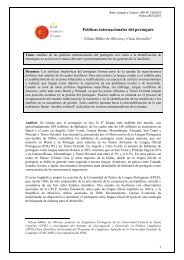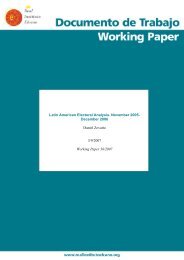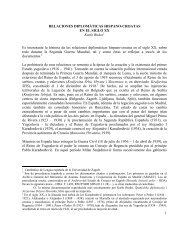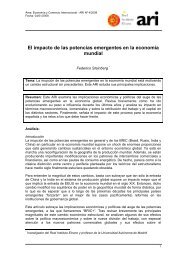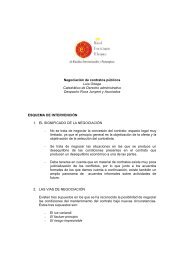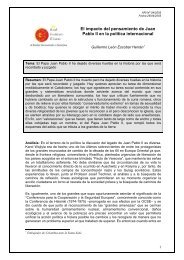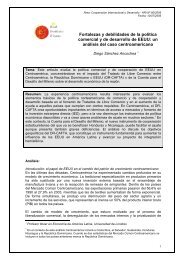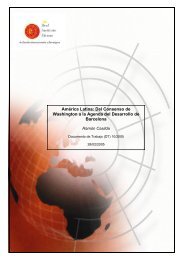Spain and the United States - Real Instituto Elcano
Spain and the United States - Real Instituto Elcano
Spain and the United States - Real Instituto Elcano
You also want an ePaper? Increase the reach of your titles
YUMPU automatically turns print PDFs into web optimized ePapers that Google loves.
LOOKING AHEAD 131<br />
Exhibit 7.7 Employment, Productivity <strong>and</strong> R&D Spending<br />
More worryingly, <strong>Spain</strong>’s declining productivity denotes <strong>the</strong> lack of<br />
technological progress, something that hinders <strong>the</strong> economy’s overall<br />
efficiency <strong>and</strong> its long-term growth capacity. This can be seen from <strong>the</strong> small<br />
rise in total factor productivity (TFP, an approximate indicator of <strong>the</strong> growth in<br />
technological progress), which increased in manufacturing by an average of<br />
only 0.3% a year between 1996 <strong>and</strong> 2002, compared with 2.5% in 1980-1995,<br />
according to <strong>the</strong> Bank of <strong>Spain</strong>, which noted that this decline is “somewhat<br />
more than a temporary effect linked to an episode of vigorous job creation or<br />
of changes in <strong>the</strong> sectoral composition of employment.” O<strong>the</strong>r labour market<br />
analysts have reached <strong>the</strong> same conclusion. 7 And this is occurring at a time<br />
when foreign direct investment is slowing considerably (FDI having been one<br />
of <strong>the</strong> main channels for <strong>the</strong> diffusion of technological advances), <strong>and</strong> in which<br />
<strong>the</strong> weight of high-technology imports remains very limited, despite <strong>the</strong> surge<br />
in import penetration.<br />
Among <strong>the</strong> EU-15 countries, <strong>Spain</strong> is one of <strong>the</strong> main laggards in meeting<br />
<strong>the</strong> objectives of <strong>the</strong> Lisbon Agenda launched in 2000 to make <strong>the</strong> EU by 2010<br />
“<strong>the</strong> most dynamic <strong>and</strong> competitive knowledge-based economy in <strong>the</strong> world<br />
capable of sustainable economic growth with more <strong>and</strong> better jobs” (see<br />
Exhibit 7.7). <strong>Spain</strong>’s spending on R&D represents, for example, 1.1% of GDP,<br />
less than half <strong>the</strong> 2.7% spent by <strong>the</strong> <strong>United</strong> <strong>States</strong>. There is considerable<br />
discontent among <strong>Spain</strong>’s scientific community, many of whose best brains<br />
7. See, for example, “Perfiles TIC como agentes tecnológicos en la empresa. ¿Qué tipo de profesional<br />
necesita la empresa para gestionar las Tecnologías de la Información?” by Valeriano Muñoz, Summer Courses of<br />
<strong>the</strong> Complutense University, El Escorial, 2003. This document expressed concern at <strong>the</strong> slower pace of<br />
productivity growth, which was due not only to <strong>the</strong> very strong creation of jobs.



